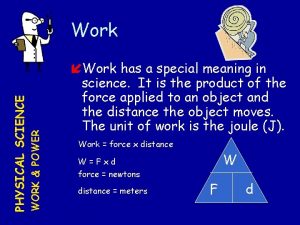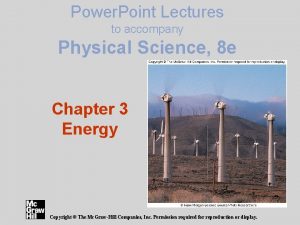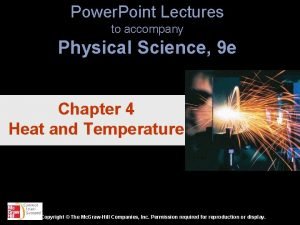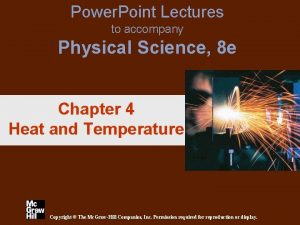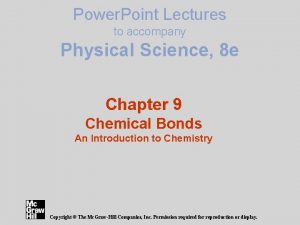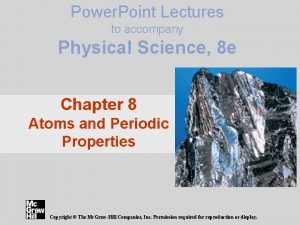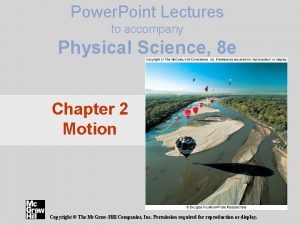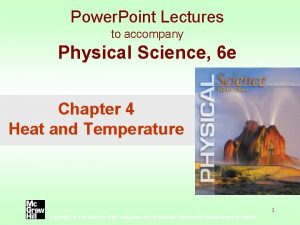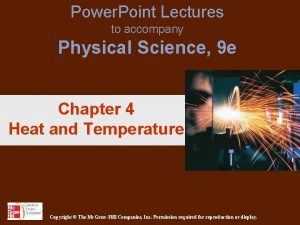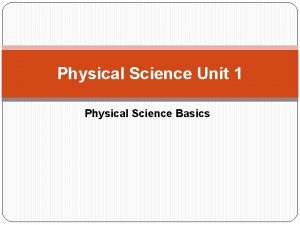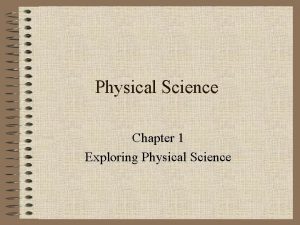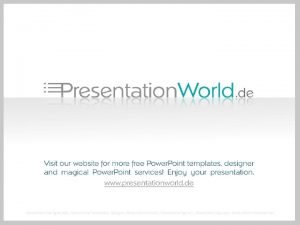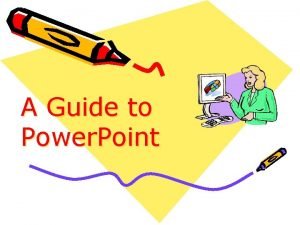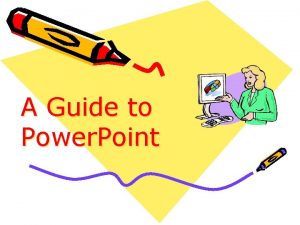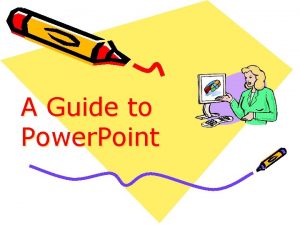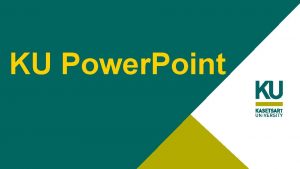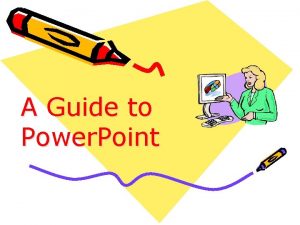Power Point Lectures to accompany Physical Science 8









































- Slides: 41

Power. Point Lectures to accompany Physical Science, 8 e Chapter 6 Electricity Copyright © The Mc. Graw-Hill Companies, Inc. Permission required for reproduction or display.

Core Concept Electric and magnetic fields interact and can produce forces.

Concepts of Electricity • Electron theory of charge – Ancient mystery: “Amber effect” – J. J. Thompson: identified negatively charged electrons • Today: – Basic unit of matter = atom – Atoms made up of electrons and nuclei containing positively charged protons and neutral neutrons (See Ch. 8)

Electric Charge • Charges in matter – Inseparable property of certain particles – Electrons: negative electric charge – Protons: positive electric charge • Charge interaction – Electric force – “Like charges repel; unlike charges attract” • Ions: non-zero net charge from loss/gain of electrons

Static Electricity • Electrostatic charge – Stationary charge confined to an object • Charging mechanisms – Friction – Contact with a charged object – Polarization (reorientation induced without changing net charge)

Electrical Conductors and Insulators • Electrical conductors – Electrons are free to move throughout material – Added charge dissipates – Examples: metals, graphite (carbon) • Electrical insulators – Electron motions restricted – Added charge tends to remain on object – Examples: Glass, wood, diamond (carbon) • Semiconductors – Conduct/insulate depending on circumstances – Applications: Computer chips, solar cells, . . .

Electric Charge • Unit of charge = coulomb (C) – Equivalent to charge of 6. 24 x 1018 electrons! – Metric unit of charge • Electron charge – Fundamental charge – Smallest seen in nature – Quantity of charge and the number of electrons

Electrostatic Forces Coulomb’s law • Relationship giving force between two charges • Similar to Newton’s law of gravitation • k versus G implies gravity weaker

Force Fields How do forces act through space? • Charges surrounded by electric fields (Vector fields/directional) • Fields and charges inseparable • Fields act on other charges – Direction of fields = motion of positive test charge in the field – Visualized with lines of force • Same ideas apply to gravity and magnetism

Force Fields How do forces act through space? • Charges surrounded by electric fields (Vector fields/directional) • Fields and charges inseparable • Fields act on other charges – Direction of fields = motion of positive test charge in the field – Visualized with lines of force • Same ideas apply to gravity and magnetism

Electric Potential • Scalar field associated with potential energy • Units = volts (V) • Related to work involved in positioning charges • Potential difference important in producing forces and moving charges • Analogous to moving masses in gravitational fields

Electric Current Earlier - electrostatics • Charges more or less fixed in place Now - charge allowed to move • Electric current – Flow of charge – Reason for charge flow - potential (voltage) differences • Electric circuits – Structures designed to localize and utilize currents

The Electric Circuit Structure • Voltage source – Energy input – Necessary for continuing flow • Circuit elements – Energy used up as heat, light, work, … • Current flow convention: from high potential to low potential through the external circuit • Water/pump analogy

The Nature of Current • Historically - nature of “electrical fluid” unknown • Current thought to be a flow of positive charge • Reality - more complicated, depending on material • Opposite correct in metals, current = electron flow

Current Mechanisms Liquids and gases • Both positive and negative charges move, in opposite directions Metals • Delocalized electrons free to move throughout metal • “Electron gas” • Drift velocity of electrons slow • Electric field moves through at nearly light speed

More Current Details • Current = charge per unit time • Units = ampere, amps (A) • Direct current (DC) – Charges move in one direction – Electronic devices, batteries, solar cells • Alternating current (AC) – Charge motion oscillatory – No net current flow

Electrical Resistance • Loss of electron current energy • Two sources – Collisions with other electrons in current – Collisions with other charges in material • Ohm’s law

More on Resistance • Resistance factors – – Type of material Length Cross-sectional area Temperature • Superconductors – Negligible resistance at very low temperatures

Electrical Power and Work Three circuit elements contribute to work Power in circuits • Voltage source • Electrical device • Conducting wires – Maintain potential difference across device – Input wire at higher potential than output wire – Output wire = "ground" for AC circuits – No potential difference, no current (bird on a wire) Electric bills

Magnetism Earliest ideas • Associated with naturally occurring magnetic materials (lodestone, magnetite) • Characterized by “poles” - “north seeking” and “south seeking” • Other magnetic materials - iron, cobalt, nickel (ferromagnetic) Modern view • Associated with magnetic fields • Field lines go from north to south poles

Magnetic Poles and Fields • Magnetic fields and poles inseparable • Poles always come in north/south pairs • Field lines go from north pole to south pole • Like magnetic poles repel; unlike poles attract

Sources of Magnetic Fields • Microscopic fields – Intrinsic spins of subatomic particles (electrons, protons, …) – Orbital motions of electrons in atoms • Macroscopic fields – – Permanent magnets Earth’s magnetic field Electric currents Electromagnets

Permanent Magnets • Ferromagnetic materials • Atomic magnetic moment – Electron/proton intrinsic moments – Electron orbital motion • Clusters of atomic moments align in domains • Not magnetized - domains randomly oriented • Magnetized - domains aligned

Earth’s Magnetic Field • Originates deep beneath the surface from currents in molten core • Magnetic “north” pole = south pole of Earth’s magnetic field • Magnetic declination = offset • Direction of field periodically reverses – Deposits of magnetized material – Last reversal - 780, 000 yrs. ago

Electric Currents and Magnetism • Moving charges (currents) produce magnetic fields

Electric Currents and Magnetism • Shape of field determined by geometry of current – Straight wire – Current loops – Solenoid

Electromagnets • Structure – Ferromagnetic core – Current carrying wire wrapped around core • Field enhanced by the combination • Can be turned on/off • Used in many applications: meters, switches, speakers, motors…

Electric Meters • Instrument for measuring current (ammeter) • Uses magnetic field produced by the current • Magnetic field and, hence, deflection proportional to current • Modified, can measure – Potential (voltmeter) – Resistance (ohmmeter)

Electromagnetic Switches Relays • Use low voltage control currents to switch larger, high voltage currents on/off • Mercury switch/thermostat Solenoid switches • Moveable spring-loaded iron core responds to solenoid field • Water valves, auto starters, VCR switches, activation of bells and buzzers

Telephones and Loudspeakers Coupling Acoustic Waves to Electric Currents Telephone • Sound vibrates carbon granules changing resistance • Changing resistance varies current Speaker • Varying current changes field of electromagnet, moving permanent magnet • Moving magnet vibrates spring attached to paper cone producing sound

Electric Motors • Convert electrical energy to mechanical energy • Two working parts – Field magnet - stationary – Armature - moveable electromagnet • Armature rotates by interactions with field magnet – Commutator and brushes reverse current to maintain rotation

Electromagnetic Induction Causes: • • Relative motion between magnetic fields and conductors Changing magnetic fields near conductors Effect: • Induced voltages and currents Induced voltage depends on: • • • Number of loops Strength of magnetic field Rate of magnetic field change

Generators Structure • Axle with main wire loops in a magnetic field • Axle turned mechanically to produce electrical energy AC generator • “Alternating current” • Sign of current and voltage alternate DC generator • “Direct current” • Sign of current and voltage constant

Transformers • Problems in power transmission – High currents - large resistive losses – High voltages - dangerous potential differences • Solution: transformers boost/lower AC currents and voltages • Basic relationships – Power in = power out – Number of coils to voltage

Circuit Connections • Alternating current – Practically all generated electricity – Transmitted over high voltage lines and stepped down for use in homes and industry • Direct current – Used in automobiles, cell phones, mp 3 players, laptops, … – Moveable and portable applications – Main current source is chemical batteries

Voltage Sources in Circuits • Series circuit – Negative terminal of one cell connected to positive terminal of another cell – Total voltage is the sum of single cell voltages – Single current pathway

Voltage Sources in Circuits • Parallel circuit – All negative terminals connected; all positive terminals connected – Resultant voltage determined by the largest cell voltage – Makes greater electrical energy available

Resistances in Circuits • Series connection – Total resistance is the sum of all components – Current drops as more elements are added

Resistances in Circuits • Parallel connection – More than one current path available – Overall resistance drops as more elements are added – Total circuit current increases as more elements are added

Household Circuits • Combination series and parallel circuit – Light fixtures in a room in parallel • Appliances in parallel – Same voltage available to each – Circuit breakers and fuses prevent overloads

Household Circuit Safety • Potential difference from two wires per device – Energized load carrier – Grounded or neutral wire • Three-pronged plug – Provides another grounding wire • Other devices: polarized plugs, ground-fault interrupter (GFI)
 Things that belong to salvation
Things that belong to salvation Accompany chapter 1
Accompany chapter 1 Cephalic vein in hand
Cephalic vein in hand Accompany
Accompany Power system lectures
Power system lectures Power physical science
Power physical science Draw the power triangle
Draw the power triangle What are the main branches of natural science
What are the main branches of natural science Natural and physical science
Natural and physical science Power bi power point
Power bi power point My favorite school subject
My favorite school subject Point point power
Point point power Rick trebino
Rick trebino Neonatology lectures
Neonatology lectures Data mining lectures
Data mining lectures Advanced medicinal chemistry
Advanced medicinal chemistry Uva powerpoint template
Uva powerpoint template Cs614 short lectures
Cs614 short lectures Planning a software project
Planning a software project Molecular biology lecture
Molecular biology lecture Radio astronomy lectures
Radio astronomy lectures Dr sohail lectures
Dr sohail lectures Utilities and energy lecture
Utilities and energy lecture Introduction to web engineering
Introduction to web engineering How to get the most out of lectures
How to get the most out of lectures Frcr physics lectures
Frcr physics lectures Heel effect
Heel effect Introduction to recursion
Introduction to recursion Rbc formation stages
Rbc formation stages Aerodynamics lectures
Aerodynamics lectures Theory of translation lectures
Theory of translation lectures Theory of translation lectures
Theory of translation lectures Translation 1
Translation 1 Digital logic design lectures
Digital logic design lectures Computer networks kurose
Computer networks kurose Hegel classical art
Hegel classical art Nuclear medicine lectures
Nuclear medicine lectures Cs106b
Cs106b Cdeep lectures
Cdeep lectures Oral communication 3 lectures text
Oral communication 3 lectures text C programming and numerical analysis an introduction
C programming and numerical analysis an introduction Haematology lectures
Haematology lectures





